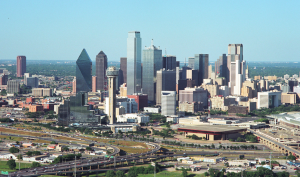
Is there any place in the metroplex more quintessentially urban than downtown Dallas? Could there be a more fun or interesting place to look for urban wildlife? I organized our last DFW Urban Wildlife group meetup intent on finding out.
The plan was to pick a weekend in late October and meet in downtown Dallas. We would explore one part of the city on Saturday, and another section on Sunday. The goal would be to find and photograph as many examples of urban wildlife as possible.
Our routes through the city were designed to take us past as many notable points of interest as possible. Many of us have lived in the metroplex for years, but few have ever taken time to visit and explore the downtown of Dallas just for the sake of it. My expectation was that this would be a fun and enjoyable way to spend a weekend whether we made any significant wildlife discoveries or not.
On Saturday we would start at City Hall and explore the southwest section of the city. Along the way we would pass by landmarks such as Pioneer Park, Reunion Tower, Dealey Plaza, Thanksgiving Square, and the Magnolia Building. We would walk a loop and finish up where we started.
Sunday would begin in the parking lot just outside the Dallas World Aquarium and follow a path that covered the northeast part of downtown. We would hit a number of parks along the way, ending with Klyde Warren Park above Woodall Rogers Expressway. We would finish up the day by lunching on enchiladas at El Fenix.
Exploring downtown Dallas for the purposes of documenting urban wildlife is something I have wanted to do for a long time now. My first inclinations began shortly after I created the DFW Urban Wildlife website in 2005. Around that time I started working for a company with offices in Dallas proper. This was my first opportunity to spend appreciable time in the downtown area, and it wasn’t long before I began noticing wildlife situations that were unexpected for me.
At the time my passion for learning about wildlife was at an all time high, but I was just starting out and still had a lot to learn. I was surprised to find a Gray Fox in downtown. I was amazed to see Red-tailed Hawks attempting to nest and going about their business among the skyscrapers. Just outside my office window I was treated to the sight of dozens and dozens of Monarch butterflies streaming by 43 stories high in the sky on their autumn migration. I was left wanting to explore the aspect of wildlife in the city further.
It took some time to come to fruition, but on the weekend of October 21-22, 2017 we finally managed to get a group of our talented naturalists downtown to do just that. We were all very eager to see what we could find, but I tried hard to temper my expectations. There would be the usual suspects, of course. Pigeon, grackles, starlings, and sparrows abound in urban areas. We knew to expect at least some birds of prey. Fox Squirrels would fill the trees in the larger parks, and there would be insects. Some animals that surely lived in the city—like rats and mice—would likely remain unseen due to their nocturnal and secretive habits.
Our suspicions were that larger animals like Coyotes, Bobcats, Gray Foxes, and Raccoons patrol the streets at night after people have vacated. We would have to make a special effort to looks for clues of their presence—like tracks and scat—in places that might reveal them.
SATURDAY, OCTOBER 21
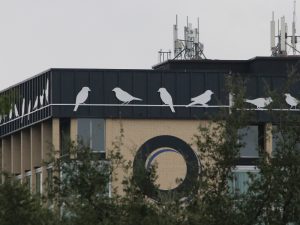
Saturday morning started out darkly overcast. The occasional light shower passed through during the first hour, lightly sprinkling us with rain. It seems I have a real talent for picking a rainy weather day, weeks and even months in advance.
We met in a parking lot close to City Hall. Across the way, bird silhouettes on the Lorenzo Hotel building offered a promise of what the day might hold in store for us.
In spite of the inclement weather, we had our first notable wildlife observation before we had even left our meeting place. A Cooper’s Hawk—individually identifiable by a dangling foot—came soaring by, heading roughly east to west over Cadiz Street. This would be the first of three Cooper’s Hawks we would see in downtown Dallas on Saturday.

Hawks are drawn to the city by the abundance of pigeons and other small birds that make up the bulk of their prey. Pigeons in particular make a high quality meal for the hawks, and we found and abundance of evidence around City Hall that these and other birds were being fed on with some regularity. The weather may have facilitated our Cooper’s Hawk sightings a bit as well. Cooper’s Hawks seem to find hunting in the rain to their advantage. The birds these hawks hunt may become more vulnerable as they hunker down to seek shelter from the rain.
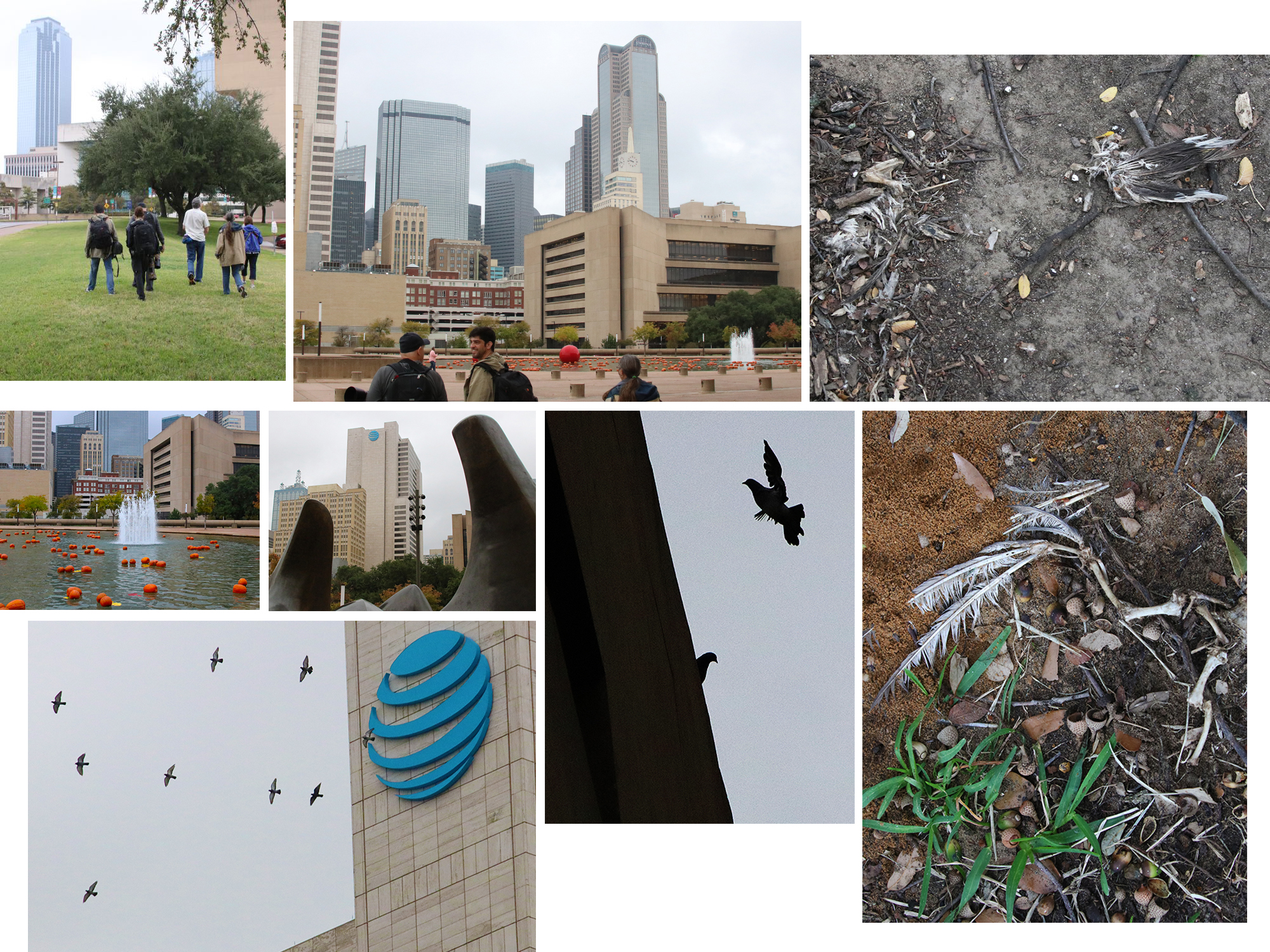
On the sidewalk in front of City Hall we found a wayward American Cockroach. All of the requisite jokes about roaches, city hall, and politicians soon ensued.
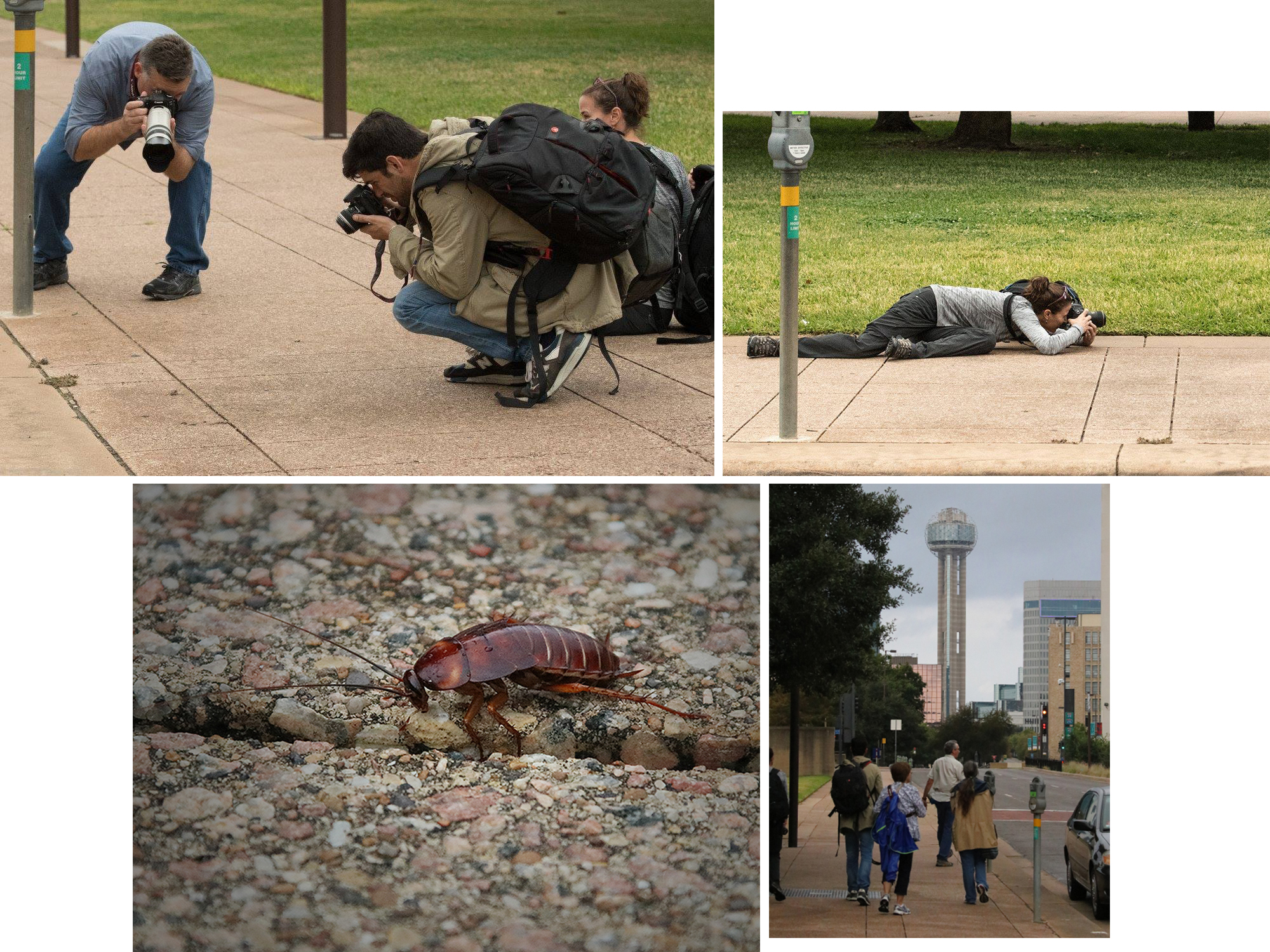
Late October is synonymous with Monarch Butterfly migration in North Texas. We were concerned that the gray skies would discourage the butterflies from making an appearance, but we spotted our first harbinger as we turned toward Pioneer Plaza and the Reunion district. There would be many more.
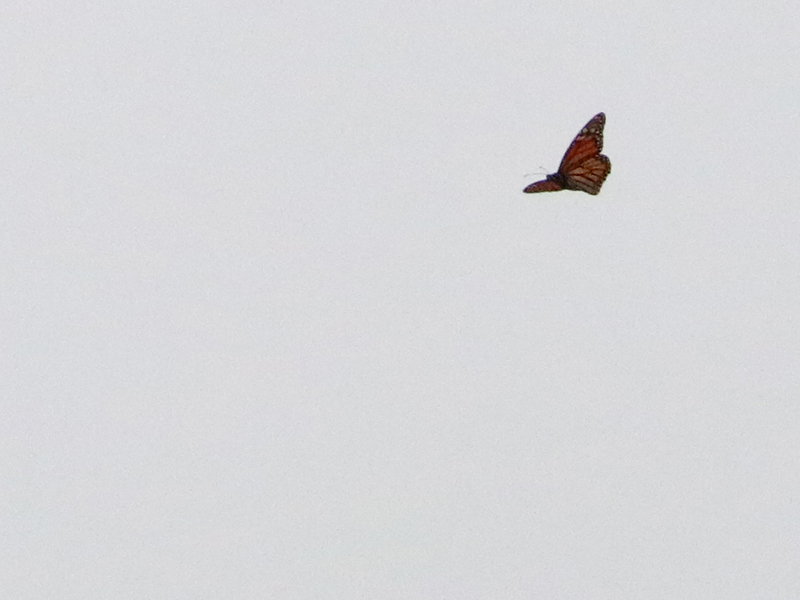
Perhaps the most unique thing we found all weekend was this piebald Great-tailed Grackle sporting small collection of white feathers in sharp contrast to his normally iridescent black plumage. We would see him again on Sunday, near the same location. This may indicate that grackles limit themselves to a relatively small territory that they patrol regularly.
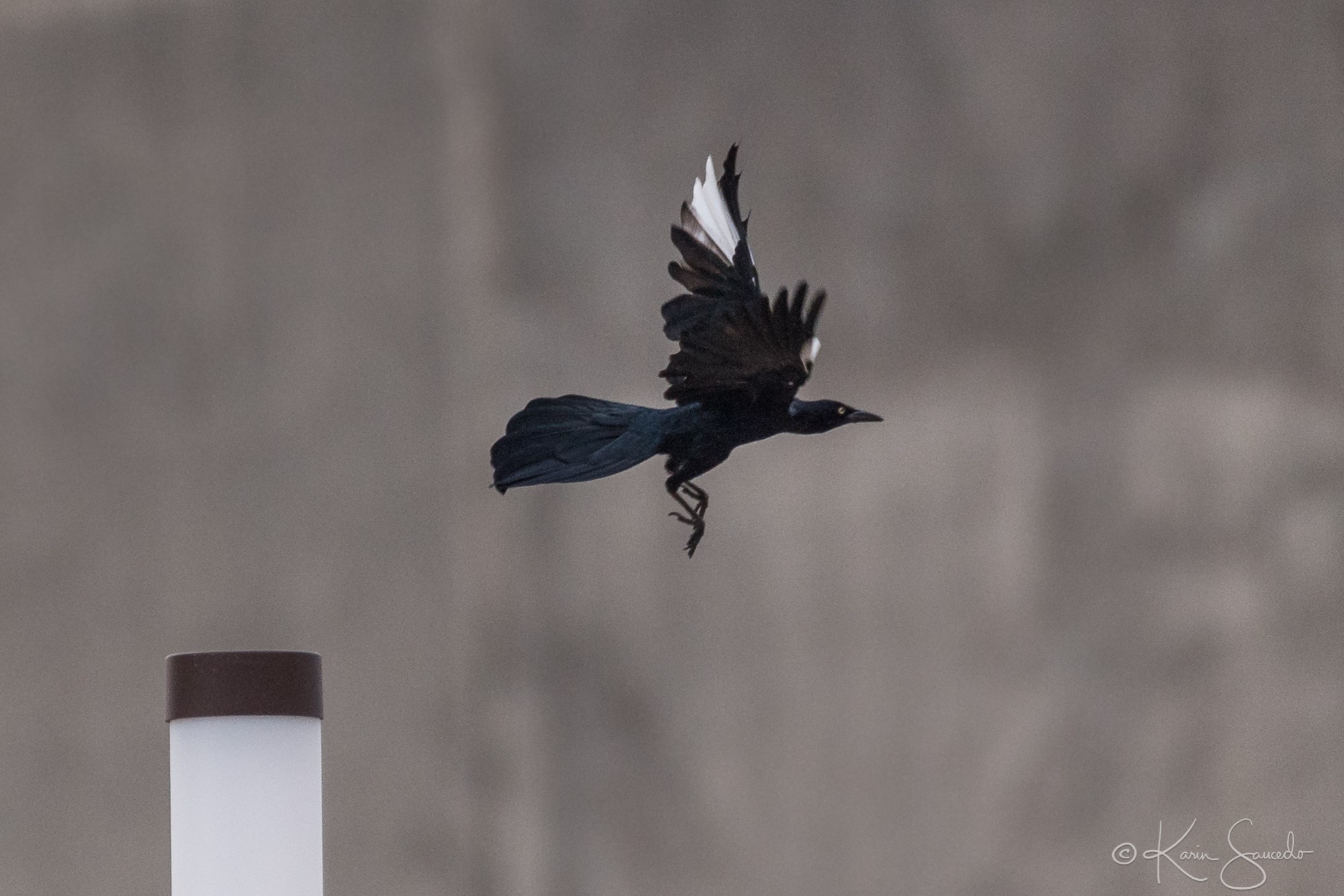
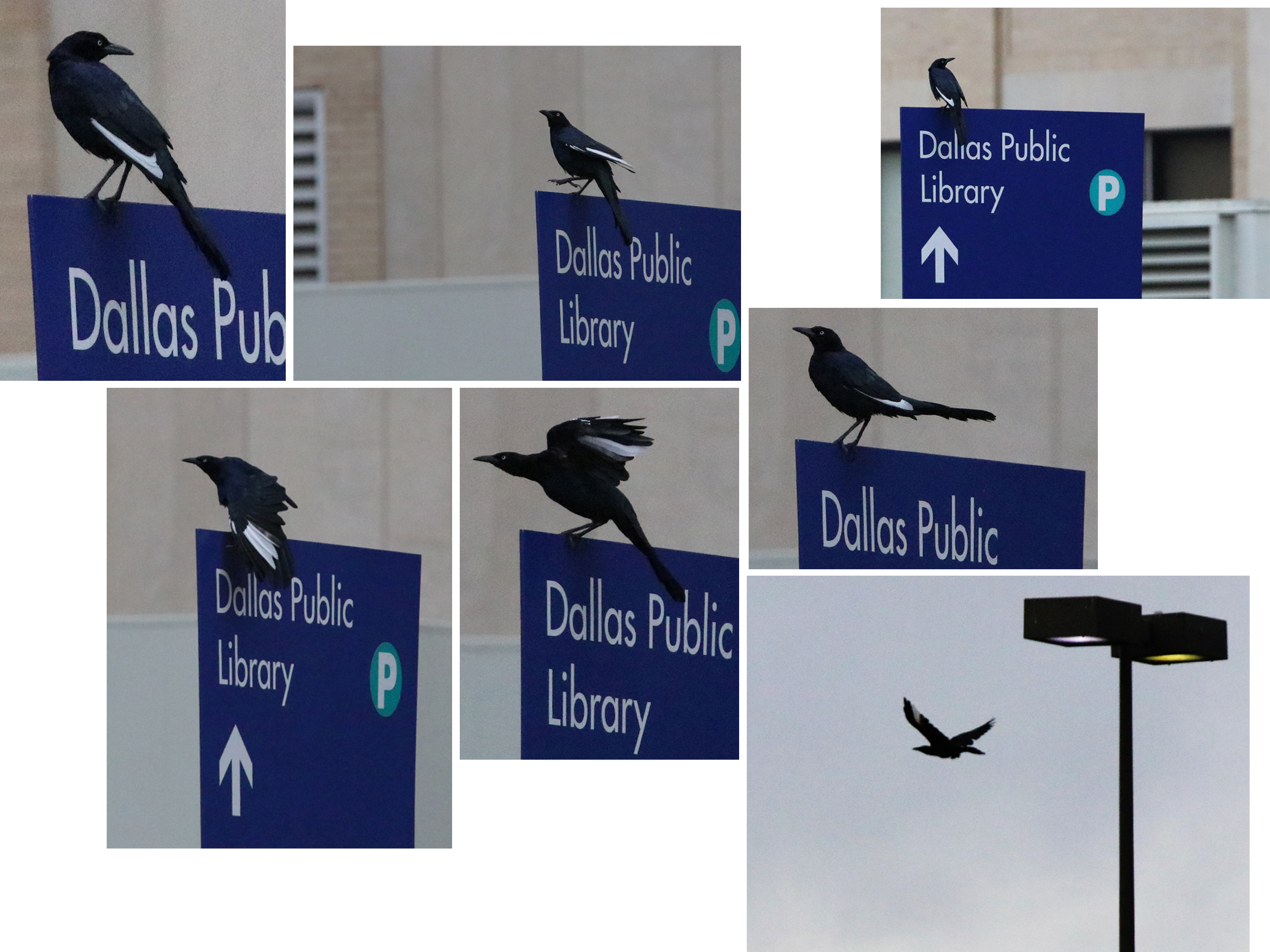
We were alerted to our second Cooper’s Hawk of the day by the sound of angry Blue Jays as we approached Pioneer Plaza. The hawk had just captured a pigeon, and was looking for a place he could eat it in peace. The Blue Jays were none too happy about this happenstance.

Pioneer Plaza and Cemetery was perhaps the most wildlife friendly place we visited on Saturday. In addition to the Cooper’s Hawk and Blue Jays, we also found many Northern Mockingbirds, several Fox Squirrels, Ruby-crowned Kinglets, a Lincoln’s Sparrow, a Common Yellowthroat (the first I’ve ever documented), many Monarchs, and a collection of Whirligig Beetles in the pond. The cemetery, with its historic headstones, and the Cattle Drive sculpture by artist Robert Summers only added to the appeal and interest of this part of downtown.

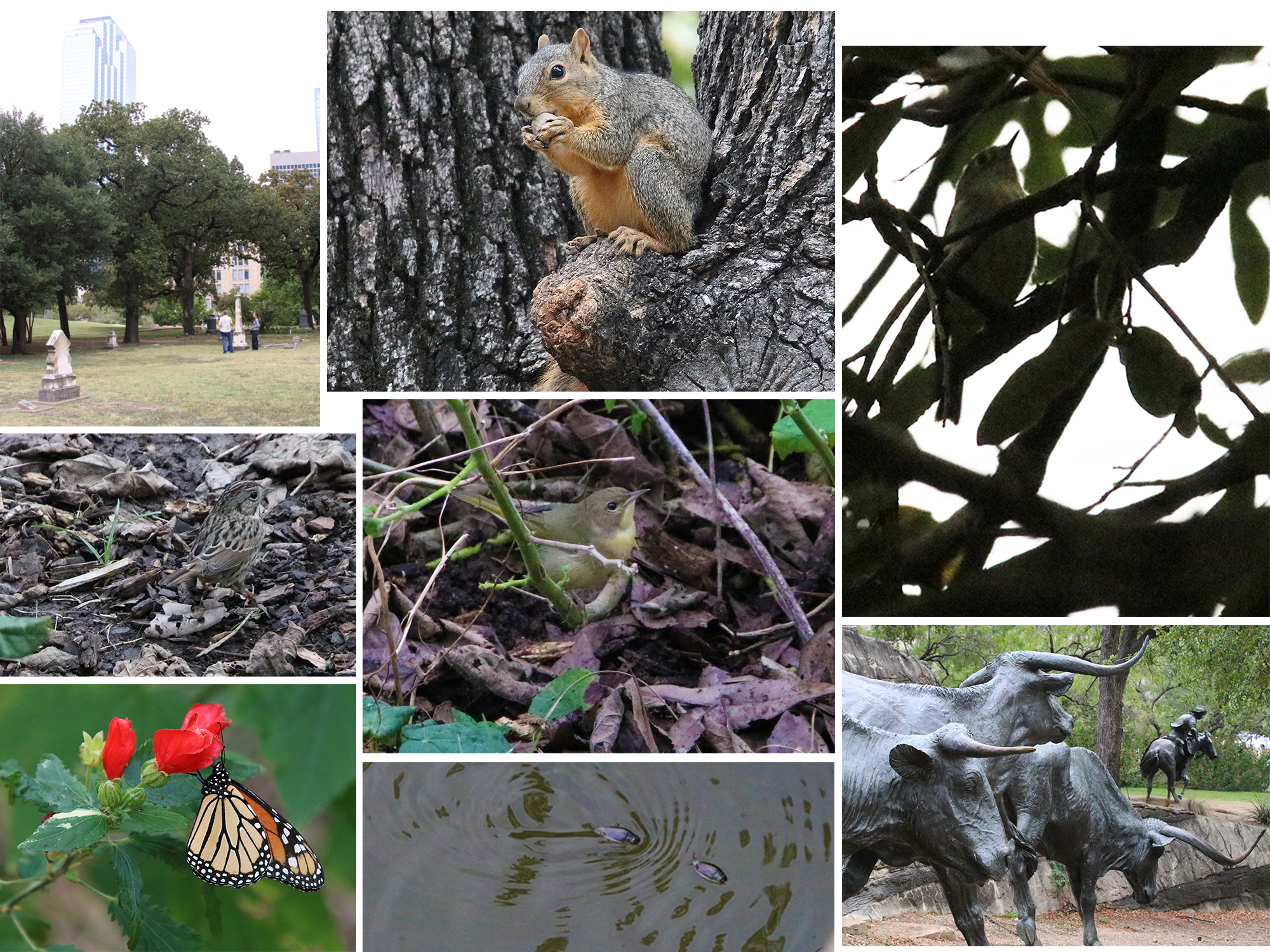
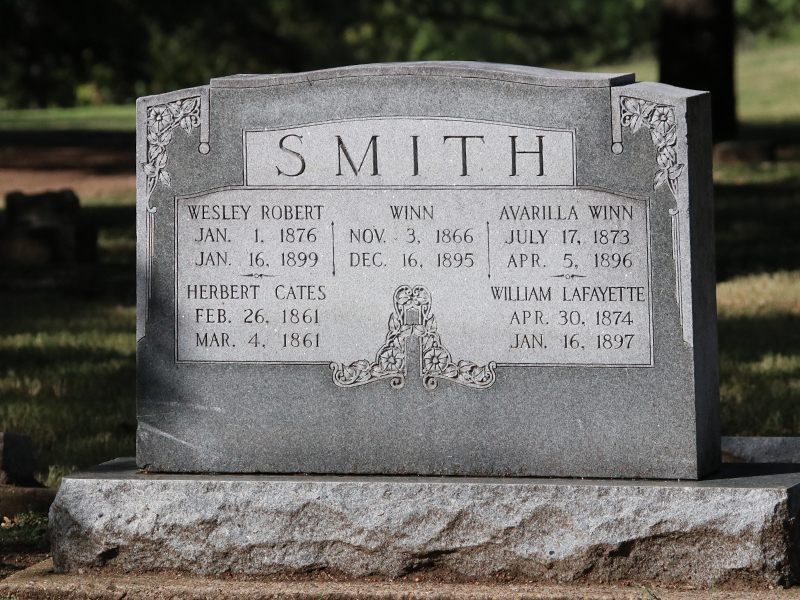
Next on our agenda was a visit to the Reunion District. Along the way we passed by the beautiful Omni Hotel, complete with the restored original Red Pegasus statue displayed on its lawn. High rise construction and a lone, intrepid worker was viewed from Austin Street. We paid Lubben Plaza Park and its unique spiral sculpture a brief visit. And we read the inscription on the Dallas Morning News building, before finally reaching our destination under the shadows of Reunion Tower.
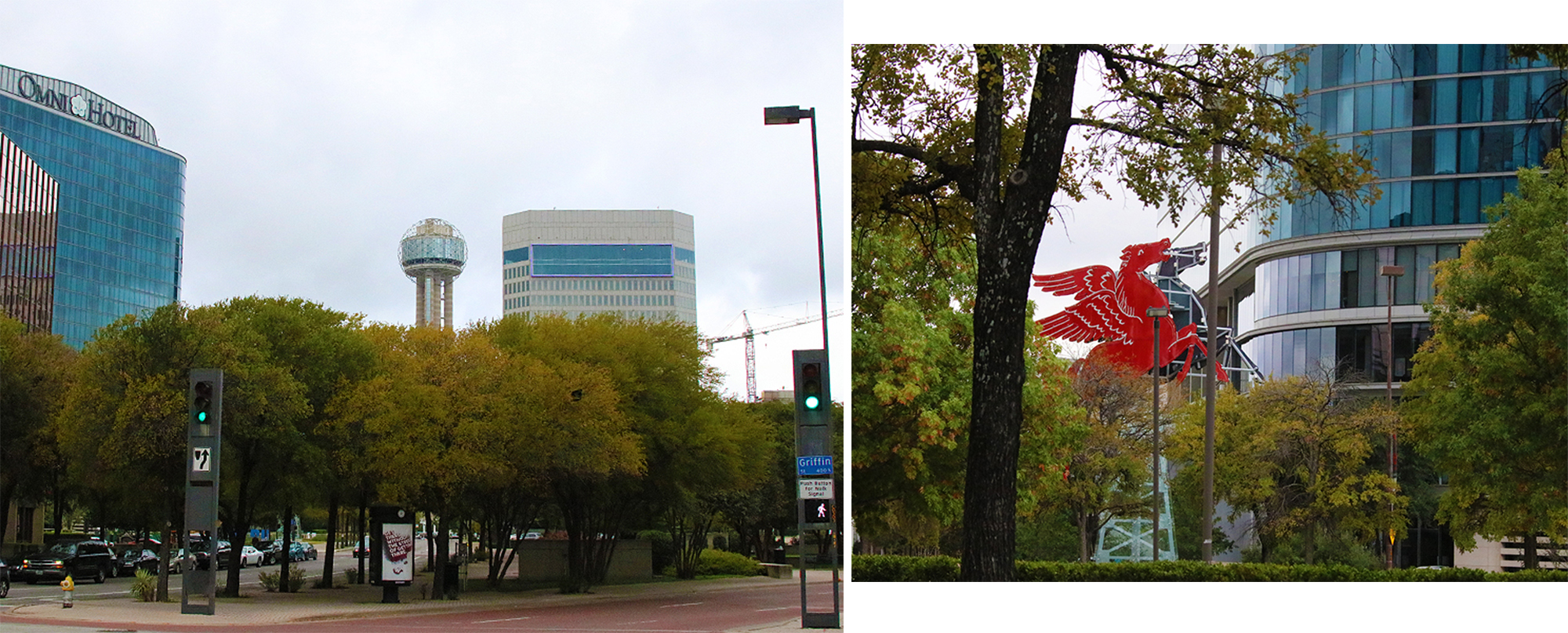


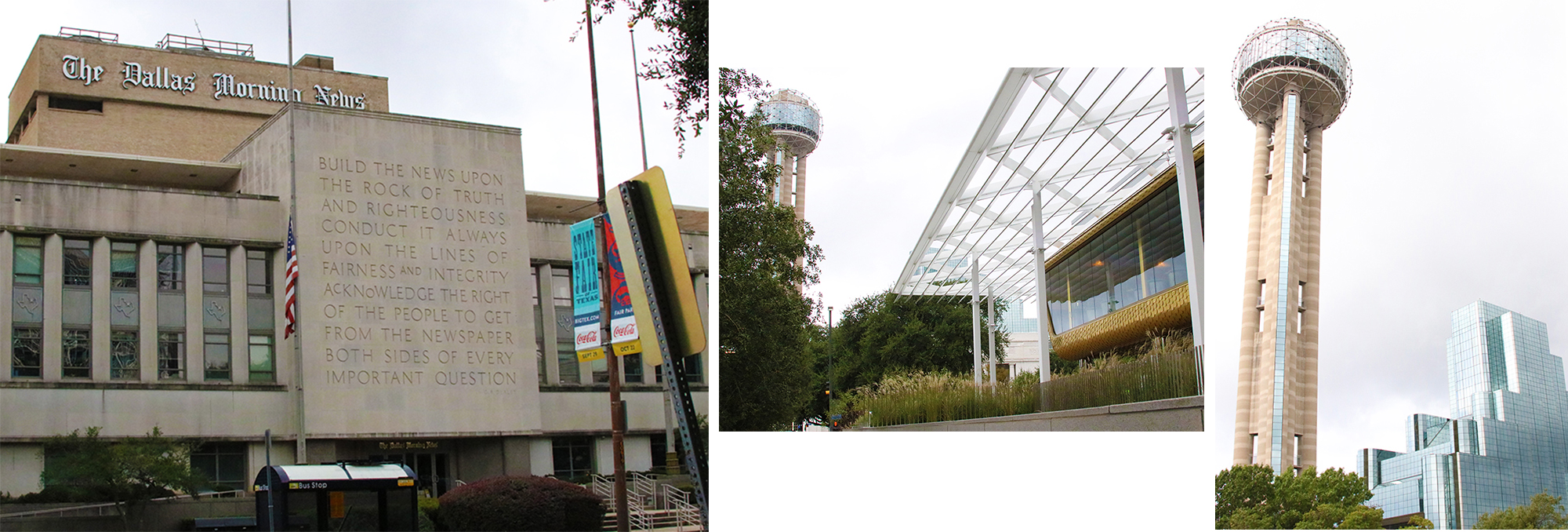
We made our way under the railroad tracks—DART, TRE, and other—to Reunion Arena Park. It was there that we really hit the mother lode of Monarchs. The small but rich flower garden in this location provided a great respite for the traveling butterflies. The views of Reunion Tower and the Hyatt Regency hotel were stunning here as well.
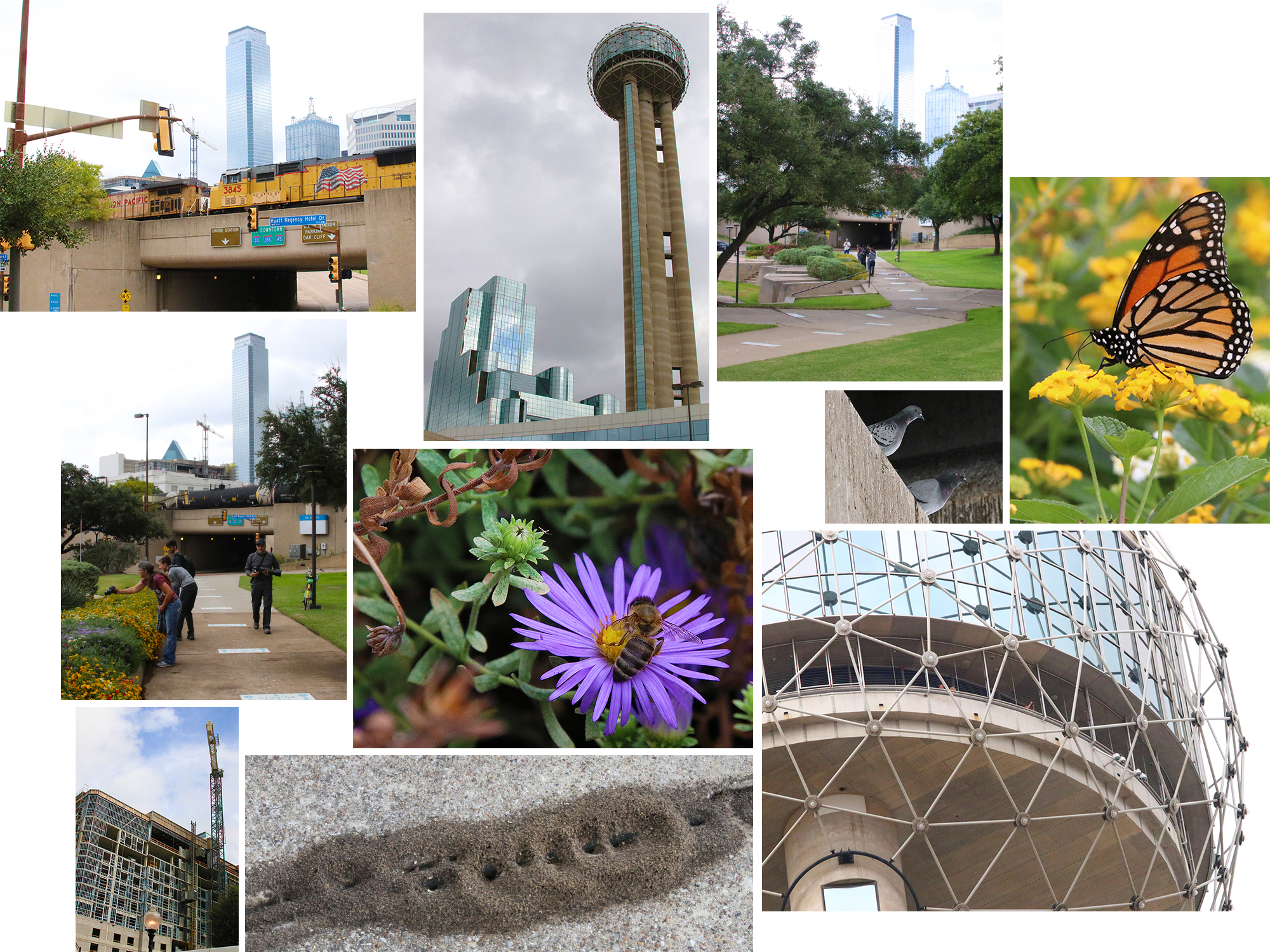

The morning’s third Cooper’s Hawk was observed in this same area. She was simply passing through, and I managed a quick picture when she stopped momentarily in one of the trees lining the Reunion Tower parking lot.

From here we made our way toward Dealey Plaza and the historic Old Red Dallas County Courthouse. As we approached the courthouse, we noted at least one pair of high flying Red-tailed Hawks. These big birds of prey tended to spend their time at altitude near the tops of downtown’s tallest skyscrapers. We would get a slightly better look at these birds on Sunday. Also in the sky along with the hawks were numerous Turkey Vultures and Black Vultures, circling endlessly on the thermals rising up out of the cityscape below.


Just around the corner from the courthouse we found the John F. Kennedy Memorial Plaza and Founder’s Plaza, which includes a replica John Neely Bryan Cabin. Here is what Wikipedia says about both…
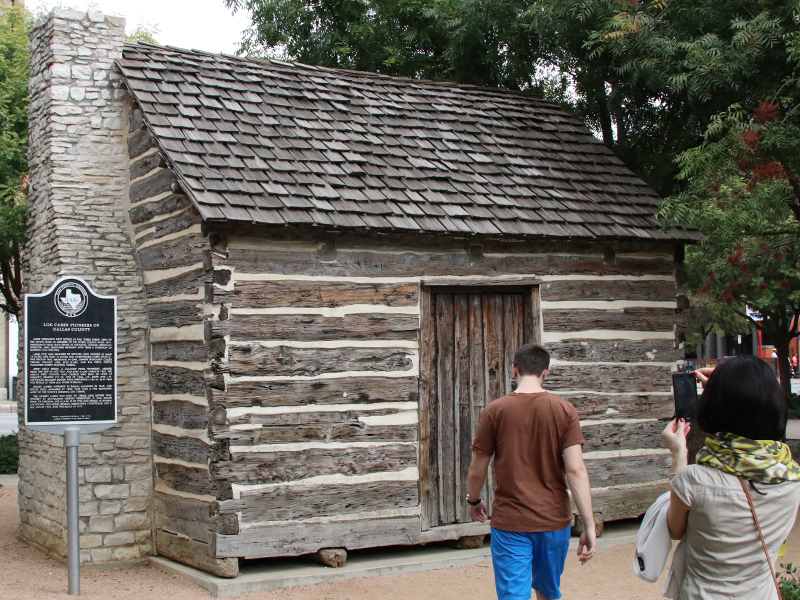
Bryan was very important to early Dallas — he served as the postmaster, a store owner, a ferry operator (he operated a ferry where Commerce Street crosses the Trinity River today), and his home served as the courthouse. In 1844, he persuaded J. P. Dumas to survey and plot the site of Dallas and possibly helped him with the work. Bryan was instrumental in the organizing of Dallas County in 1846 and in the election by voters of Dallas as its county seat in August 1850 (over the towns of Cedar Springs and Oak Cliff). When Dallas became the county seat, Bryan donated the land for the courthouse. In 1843, he married Margaret Beeman, a daughter of the Beeman family who settled in Dallas from Bird’s Fort. The couple had five children. Another Beeman, John, arrived in Dallas in April 1842 and planted the first corn.

The John F. Kennedy Memorial was the first memorial by famed American architect and Kennedy family friend, Philip Johnson, and was approved by Jacqueline Kennedy. Johnson called it “a place of quiet refuge, an enclosed place of thought and contemplation separated from the city around, but near the sky and earth.” The citizens of Dallas funded its construction entirely.
The simple, concrete memorial to President Kennedy dominates a square in downtown Dallas owned by Dallas County. It is bordered by Main, Record, Elm and Market Streets, and is one block east of Dealey Plaza, where Kennedy was assassinated.
Philip Johnson’s design is a cenotaph, or empty tomb, that symbolizes the freedom of Kennedy’s spirit. The memorial is a square, roofless room, 30 feet (9 m) high and 50 (15 m) by 50 feet (15 m) wide with two narrow openings facing north and south. The walls consist of 72 white precast concrete columns, most of which seem to float with no visible support two feet above the earth. Eight columns extend to the ground, acting as legs that seem to hold up the monument. Each column ends in a light fixture. At night, the lights create the illusion that the structure is supported by the light itself. The corners and “doors” of this roofless room are decorated with rows of concrete circles, or medallions, each identical and perfectly aligned. These decorations introduce the circular shape into the square architecture of the Kennedy Memorial.
Our next and last major stop for the day would be Thanks-Giving Square in the heart of downtown Dallas. There we were pleased to find several examples of interesting urban wildlife, all the while surrounded by the unique architecture of the square and nearby buildings. Thanks-Giving Square features fountains, a bell tower, and a non-denominational chapel building, all in the shadow of the stark and authoritarian-looking Gables Republic Tower.

Heading back to the cars in the early afternoon, we passed by the freaky Giant Eyeball sculpture on Main Street. Shortly after that we had perhaps the most unexpected of all urban wildlife sightings for the day. An Asian Elephant just outside the Magnolia Hotel. An Indian wedding was taking place there as well—coincidence?
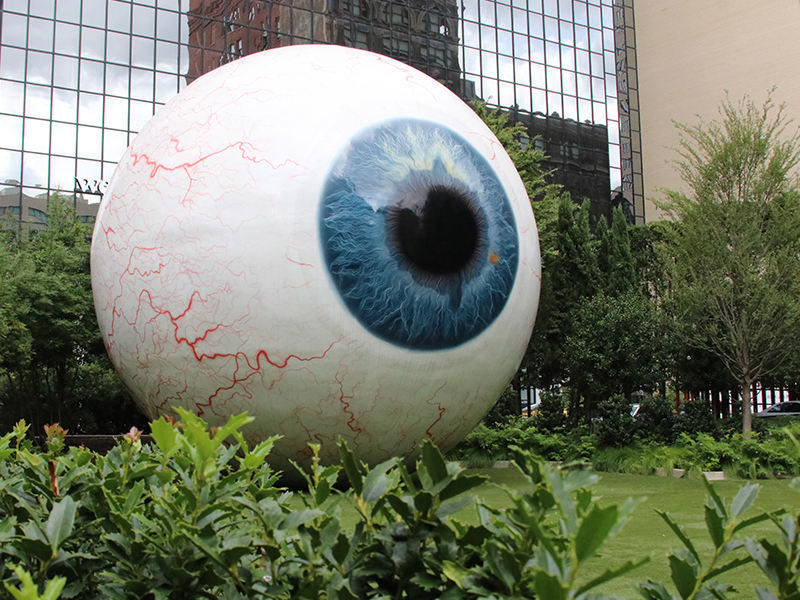
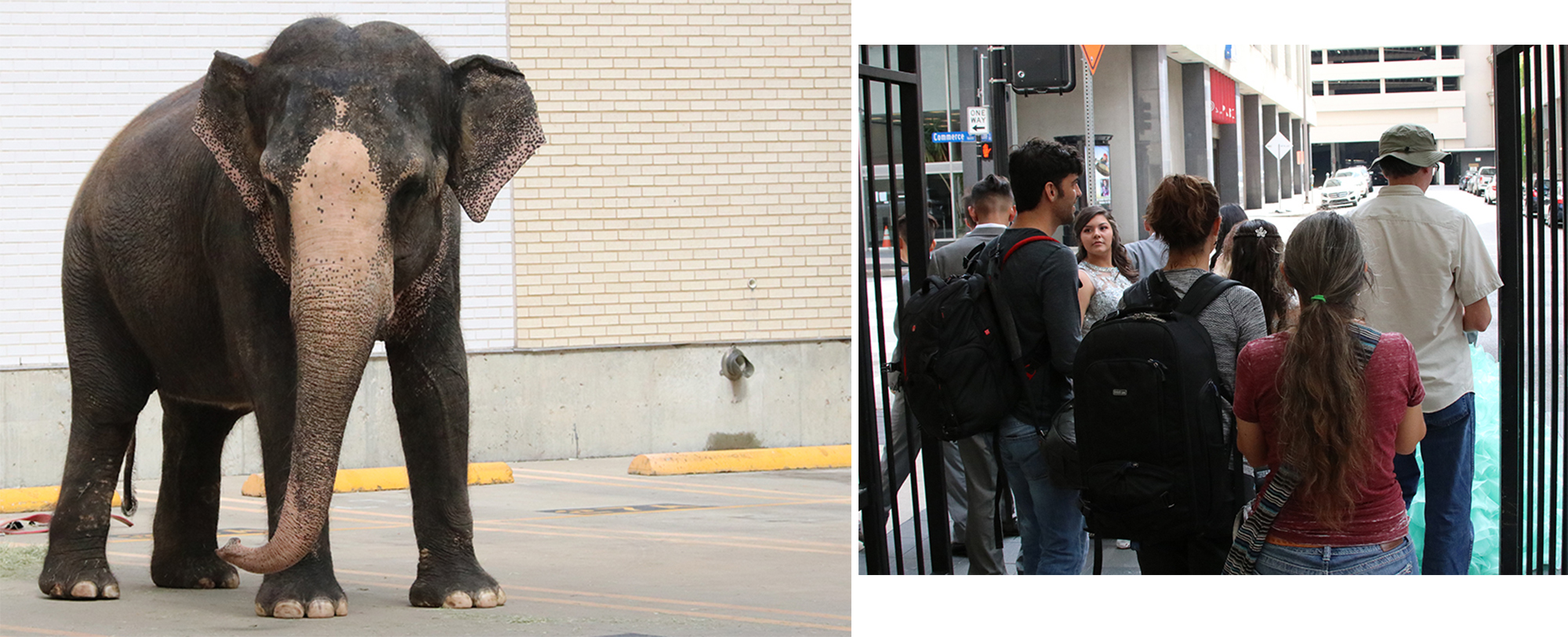
SUNDAY, OCTOBER 22
Sunday morning started with much nicer weather—sunny and warm. This time we began our trek on the north side of downtown, so that we could explore a different part of downtown. This meetup would cover much of the northeast part of the city, with just a little overlap with the route we followed the day before.
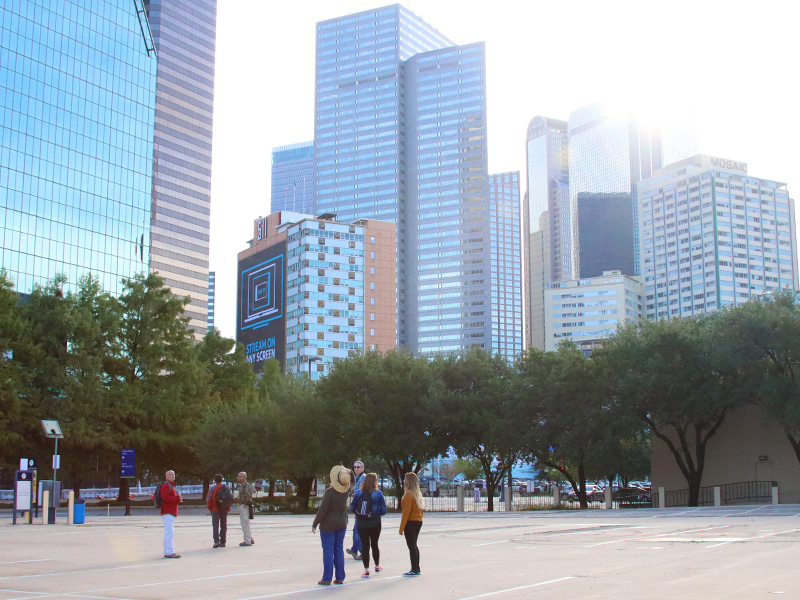
Our first important wildlife observation of the day was a Red-tailed Hawks near the Fountain Place building. There would be many more sightings of this and other big raptors as the day went on. It appears there may be two, three, or more pairs of Red-tailed Hawks living in downtown proper. Just like with the day before, a vulture or two could nearly always be found circling high above us as we made our way through the city streets. And, at the Federal Reserve Bank of Dallas on Akard Street, we were surprised to hear the call of an American Kestrel near a large, tree-lined parking lot. We never did get a visual on this bird, but the killy-killy-killy call of our smallest falcon is unmistakable.
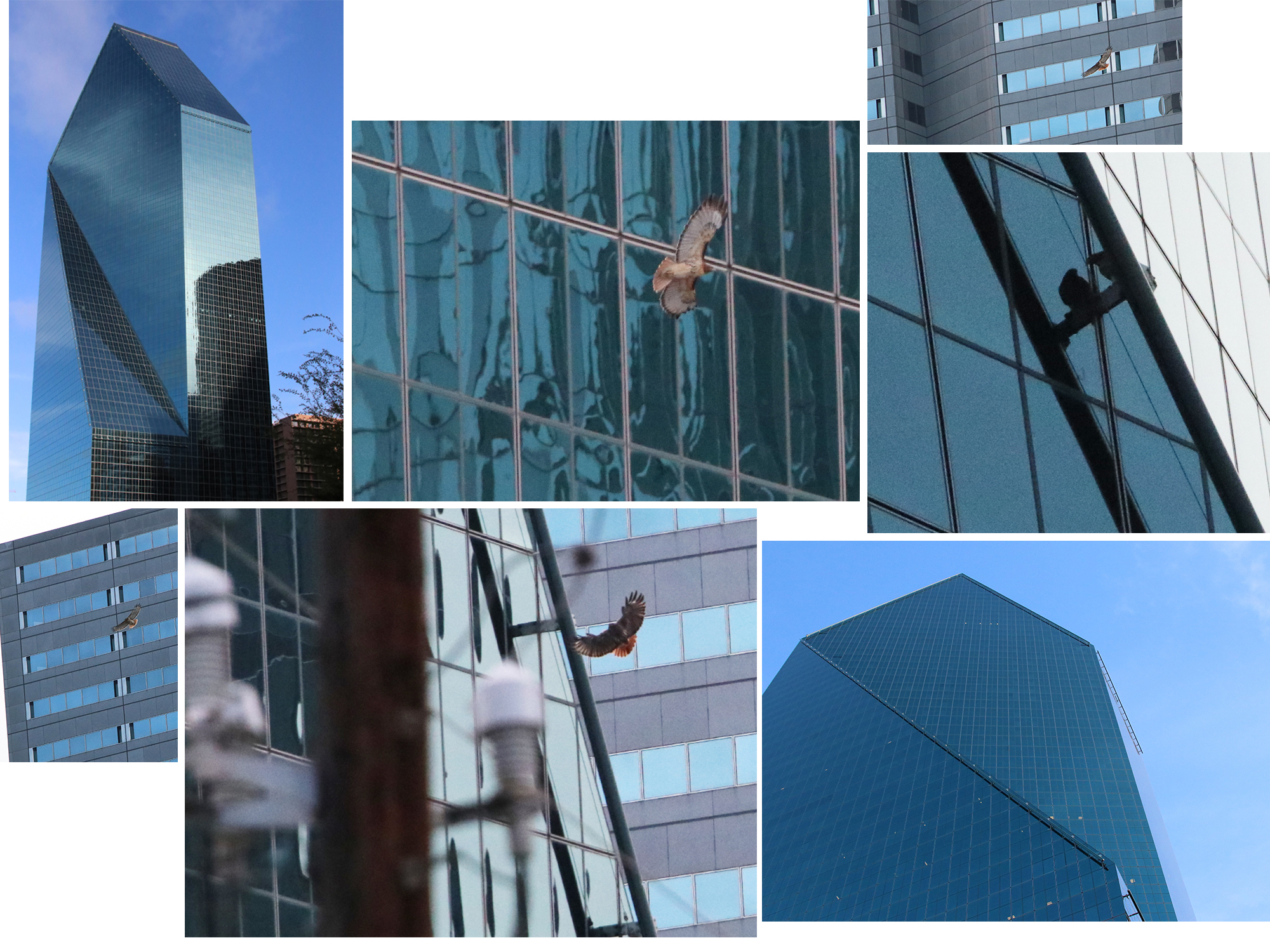

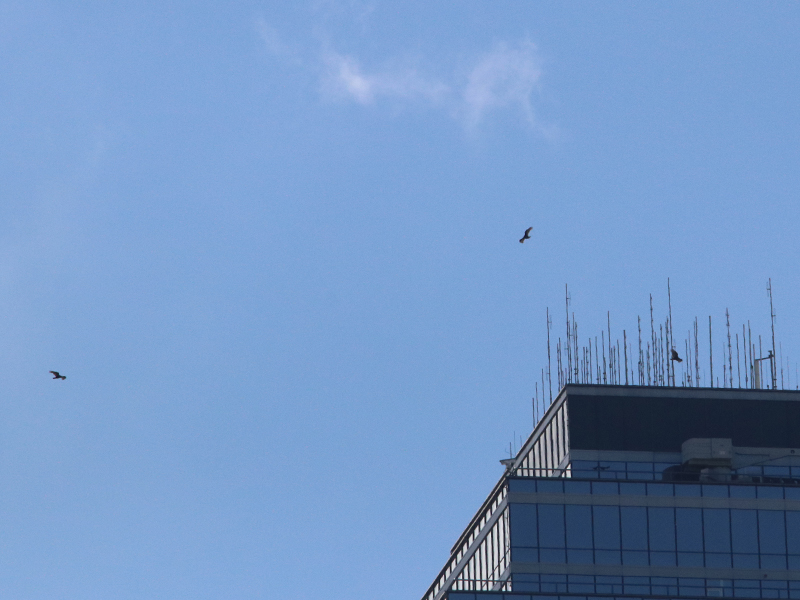
We thought for a moment that we might be able to add the Great Horned Owl to our list of observed birds of prey for the day—but that sighting turned out to be something of a Red Herring. Oh well, you can’t win them all!
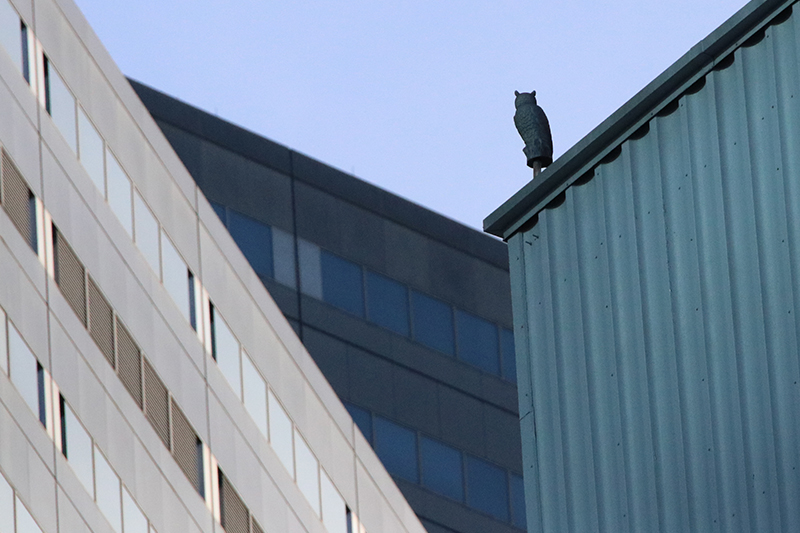
An almost over abundance of Feral Pigeon in downtown probably bests explains why so many hawks are able to survive in this very urban environment. We noted many large congregations of these birds as we made our way around downtown on Sunday morning.
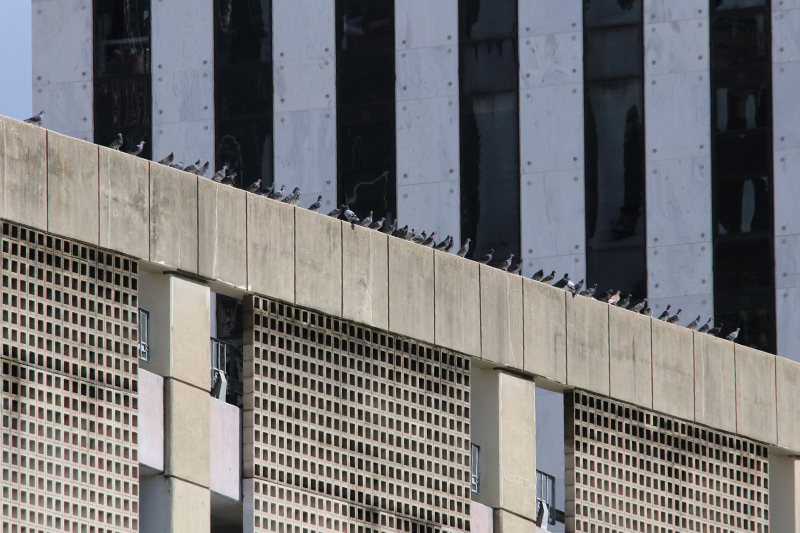
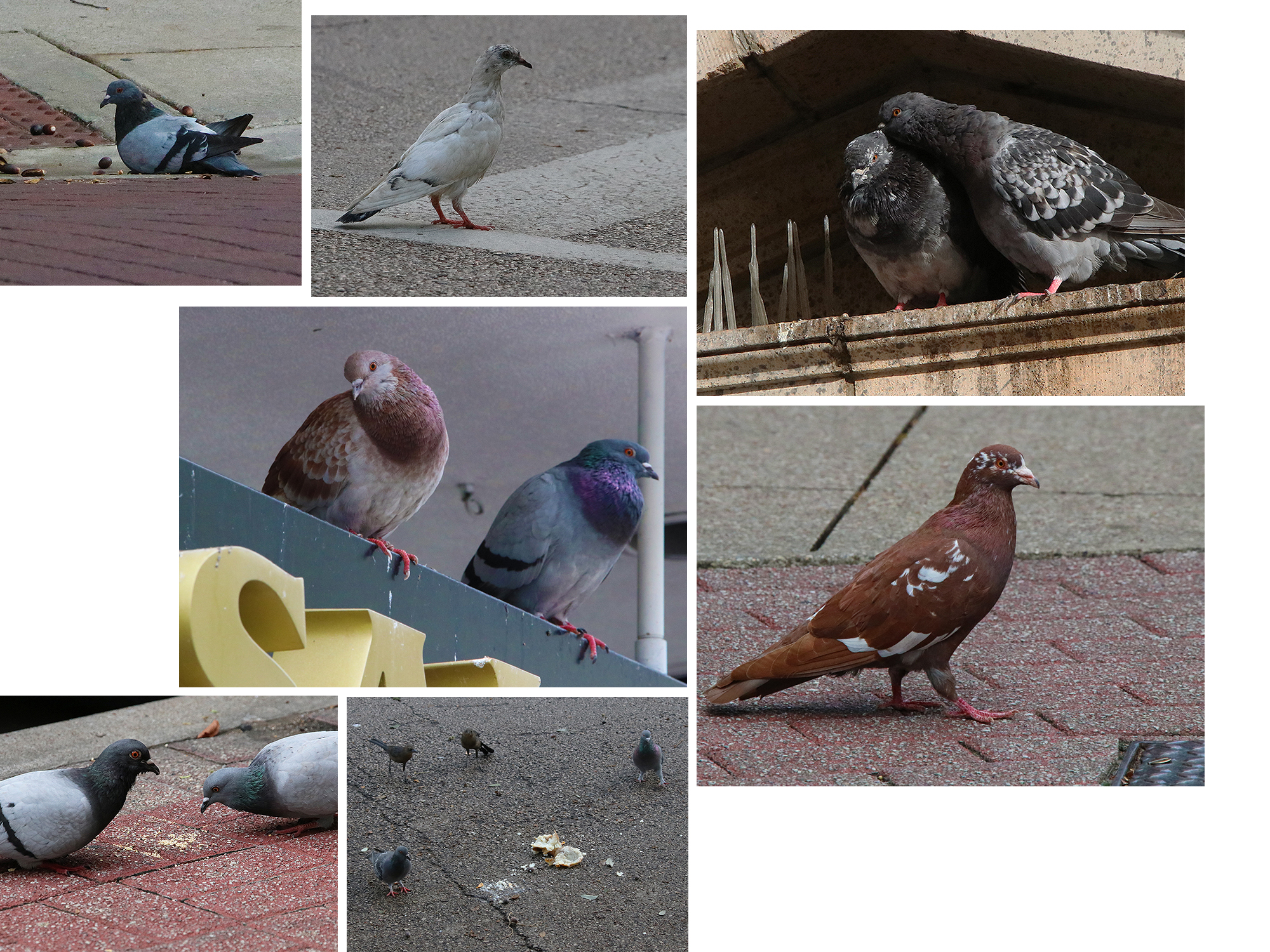
Downtown Dallas is such an out-of-the-ordinary environment for most of us. Everywhere we turned there was something interesting and new. Soaring skyscapers, works of art, and other oddities gave us plenty to look at. And the clear weather on Sunday facilitated picture taking in a way that was dampened by the gloomy overcast the day before.
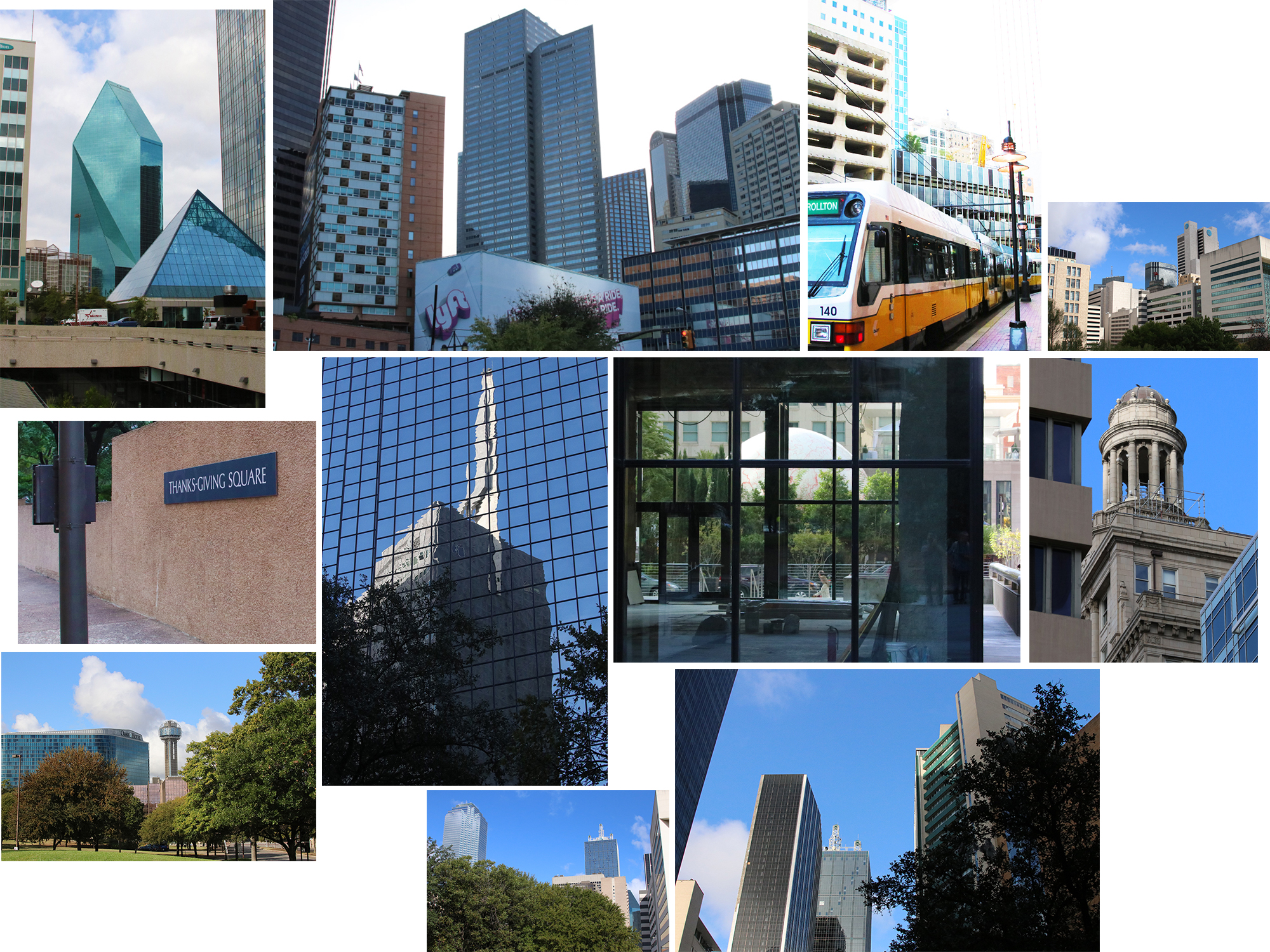
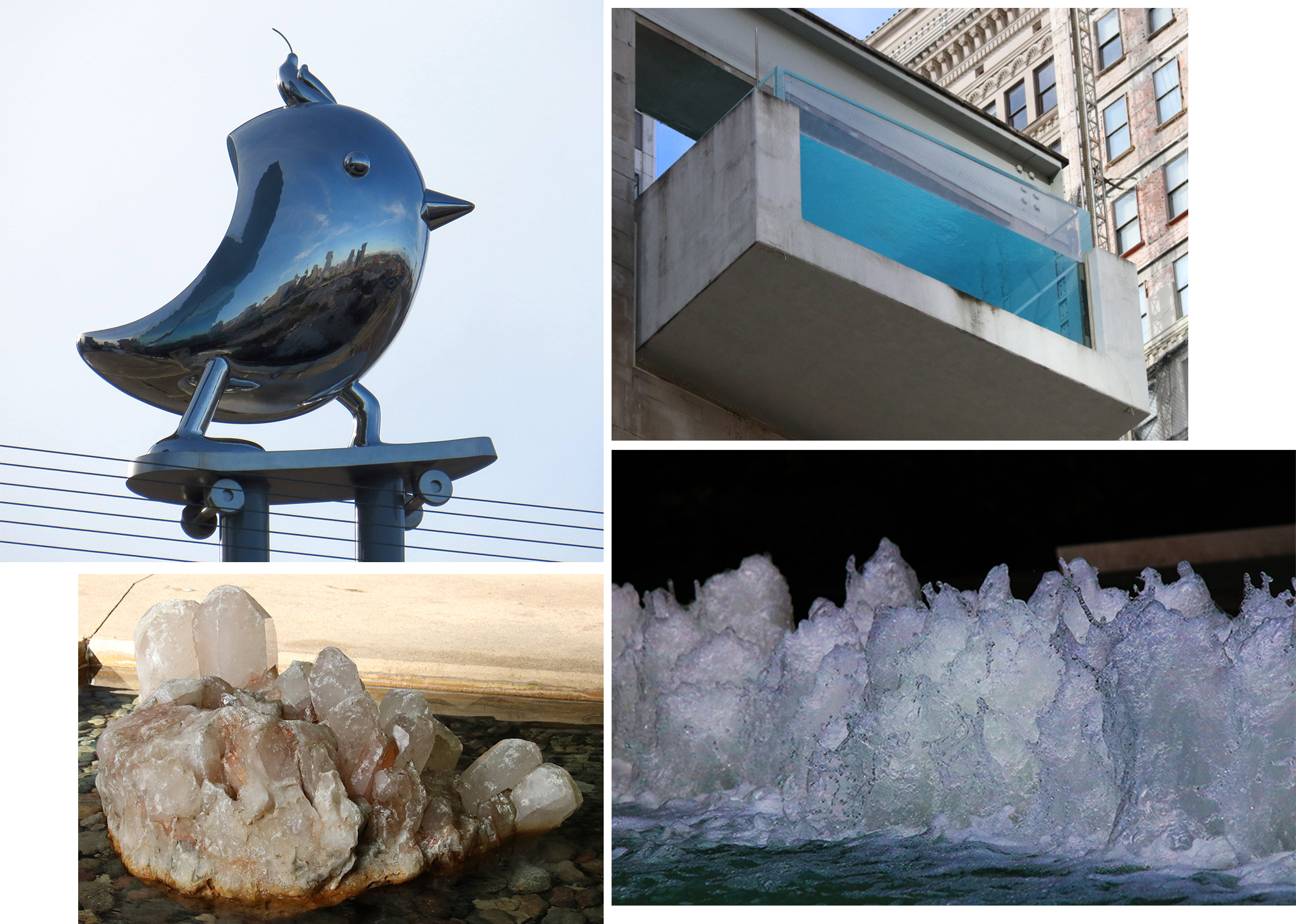
The green-roofed Magnolia Hotel Building has always been a favorite of mine. I remember the iconic Red Pegasus making a big impression on me during visits to downtown when I was a kid. Here is what Wikipedia has to say about this old, historic building…
The building, which opened next door to the Adolphus Hotel in August 1922 at a cost of US $4 million, was originally the headquarters for the Magnolia Petroleum Company. In 1934, the company erected its trademark neon Pegasus on the building’s roof (the Pegasus logo later became the logo of Mobil Oil who merged with Magnolia Petroleum in 1959) to celebrate the American Petroleum Institute’s annual meeting, held in Dallas for the first time. The rotating winged horse came to represent the city of Dallas and became one of its most recognizable and endearing landmarks, even after the building became obscured by much larger skyscrapers (the neon Pegasus can now only be seen in the downtown skyline approaching from the south).
The building was purchased by Denver, Colorado developers in 1997 and was converted into the luxury 330-room Magnolia Hotel.

Because Pioneer Plaza had been so productive the day before, we decided to pay it another brief visit on Sunday. We were glad we did. This time, sharp-eyed Shannon Barnes spotted a bee hive high in a knot hole on one of the park’s oak trees. That explains at least some of the Honey Bees we had been observing at various flower gardens around the downtown area!

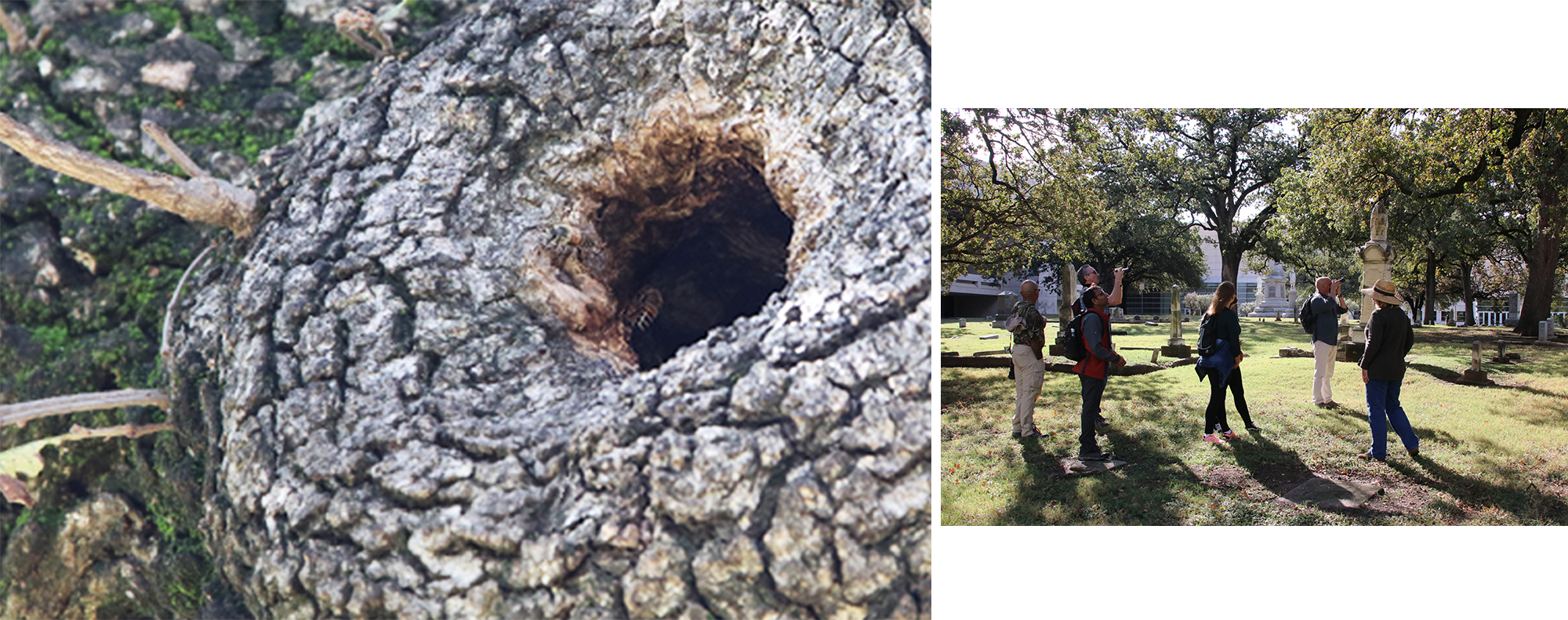
Also of note was the multitude of red galls littering the ground under the park’s trees. Examining the underside of a few leaves told the tale. These gals are the results of the reproductive activities of a tiny insect—either a midge or a wasp in the family Cynipidae. Here’s what the Texas A&M AgriLife Extension web site has to say about these galls…
Galls themselves are tumor-like growths produced by the plant in response to chemicals injected into the plant by the adult or larval gall-making insect. The shape, size and form of the gall is determined by the precise chemicals chemicals used by each species of gall-maker. The mechanisms of gall formation, and how these chemicals result in very distinctive and unique galls is still poorly understood.
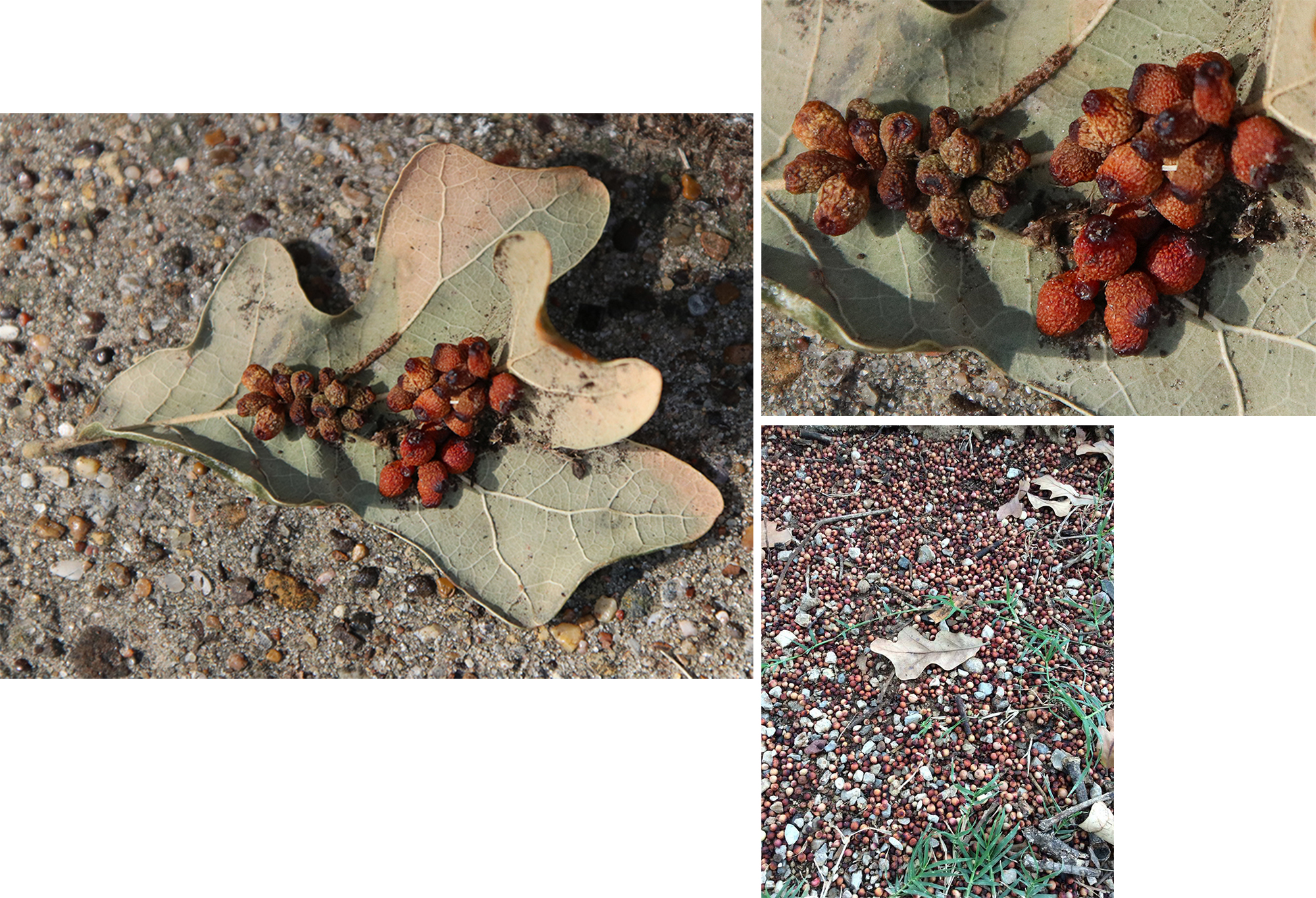
Moving on again, we ran into our friend the piebald Great-tailed Grackle in front of the J. Erik Jonsson Central Library. He was feeding on a chicken wing bone—a nice example of how wildlife leverages the abundance people surround themselves. Across the way we watched as a city employee took a moment to feed a squirrel in front of city Hall.
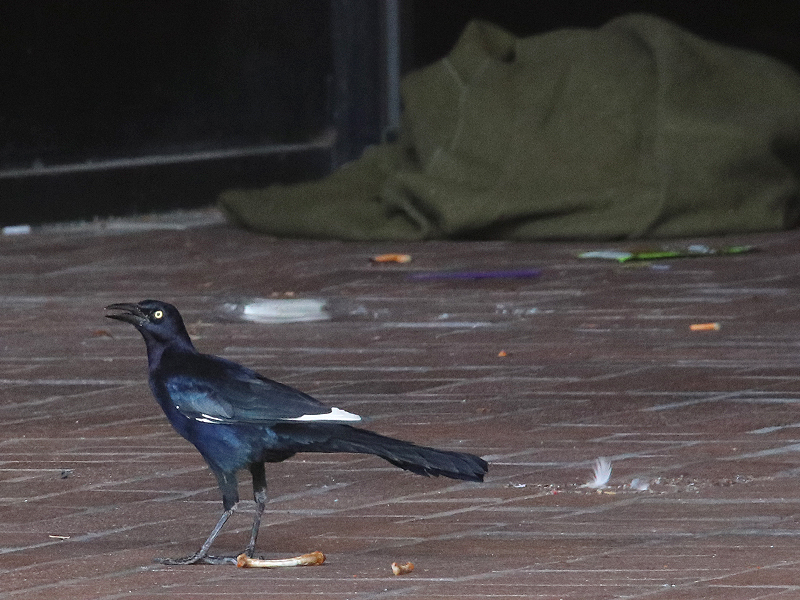
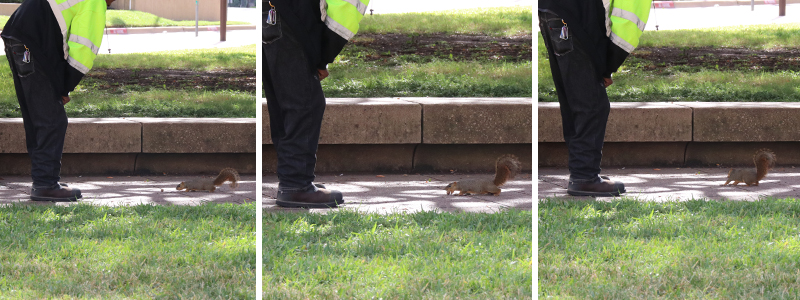
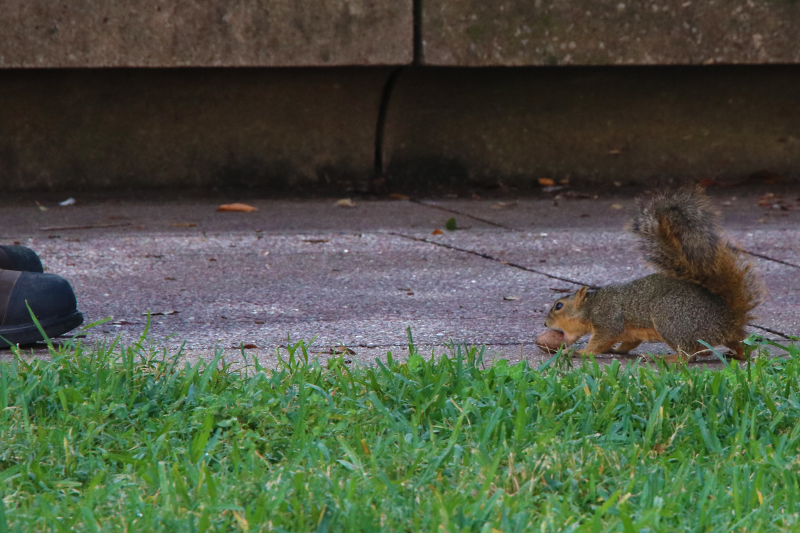
Just down the street we spotted another strange bird. The picture below shows a Lockheed P-3 Orion. A naval submarine hunter that is known to spend time at Love Field Airport from time to time. According to the Dallas Observer, this plane is at Love Field for sensor testing and upgrades.
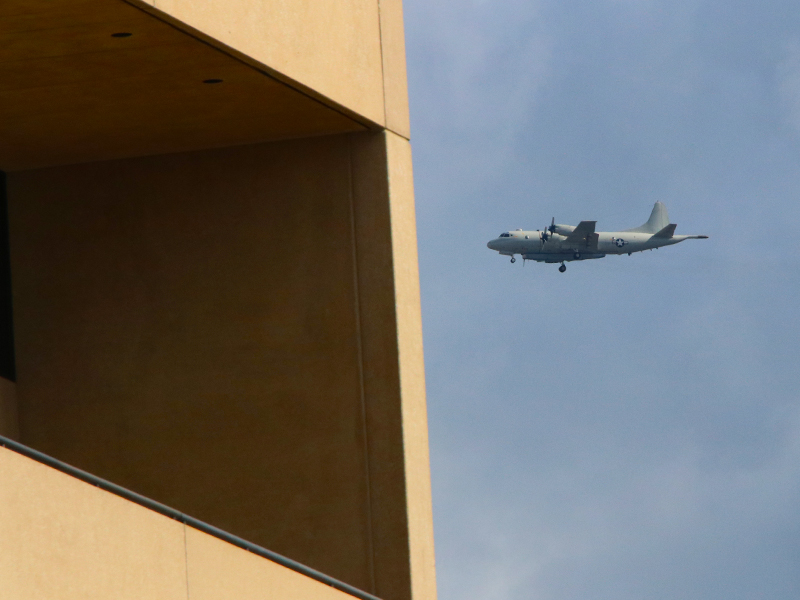
There was still much of the city to be seen as we moved along the east side of downtown. A brief stop at the Main Street Garden Park gave us another chance to spend time in a wildlife friendly spot. There we found Great-tailed Grackles, House Sparrows, Monarch Butterflies, and more Honey Bees.

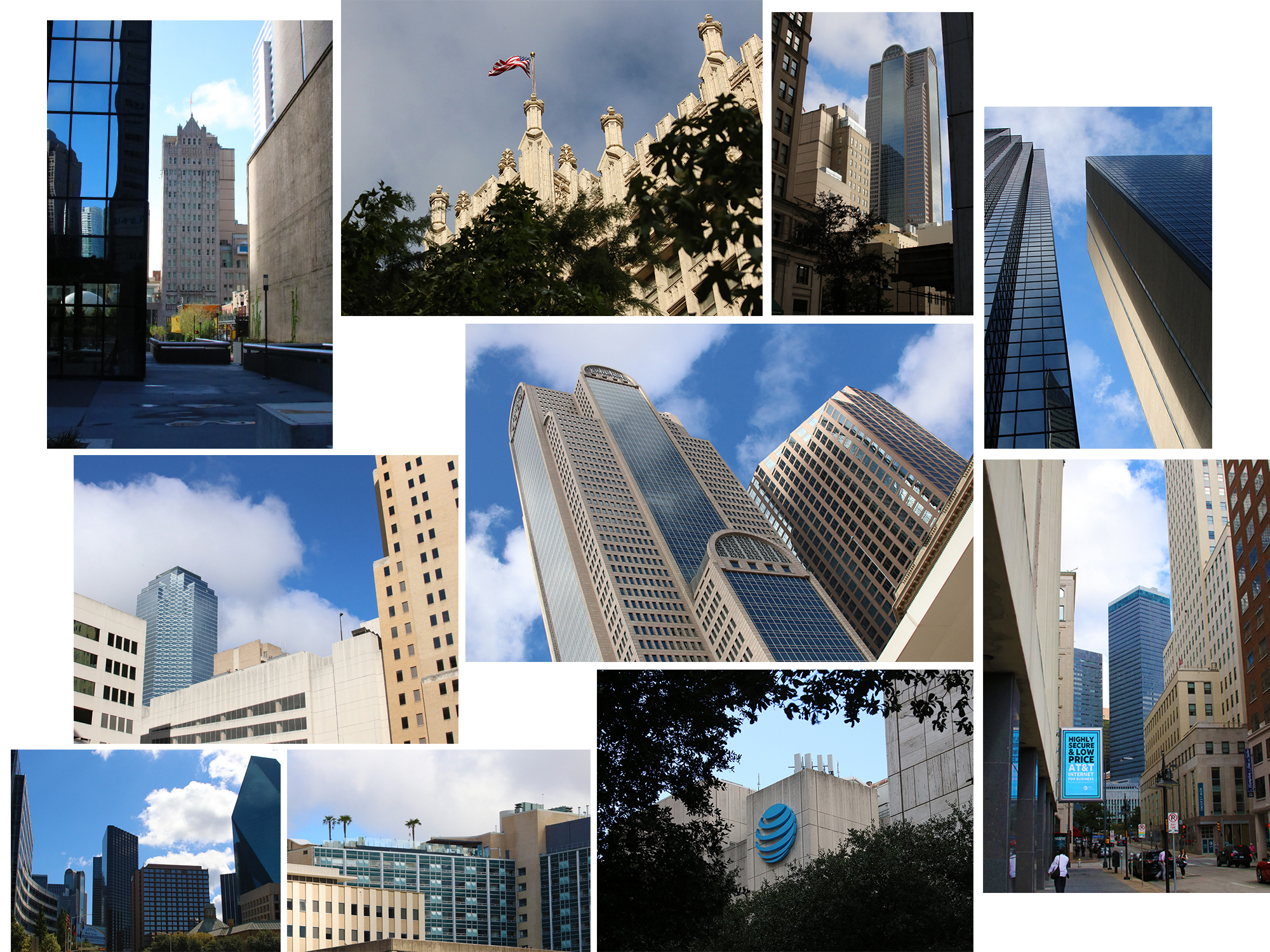
Our last major point of interest before lunch was Klyde Warren Park on the north side of downtown. This unique park sits atop Woodall Rogers Freeway, which effectively bridges the expressway to connects downtown with uptown.
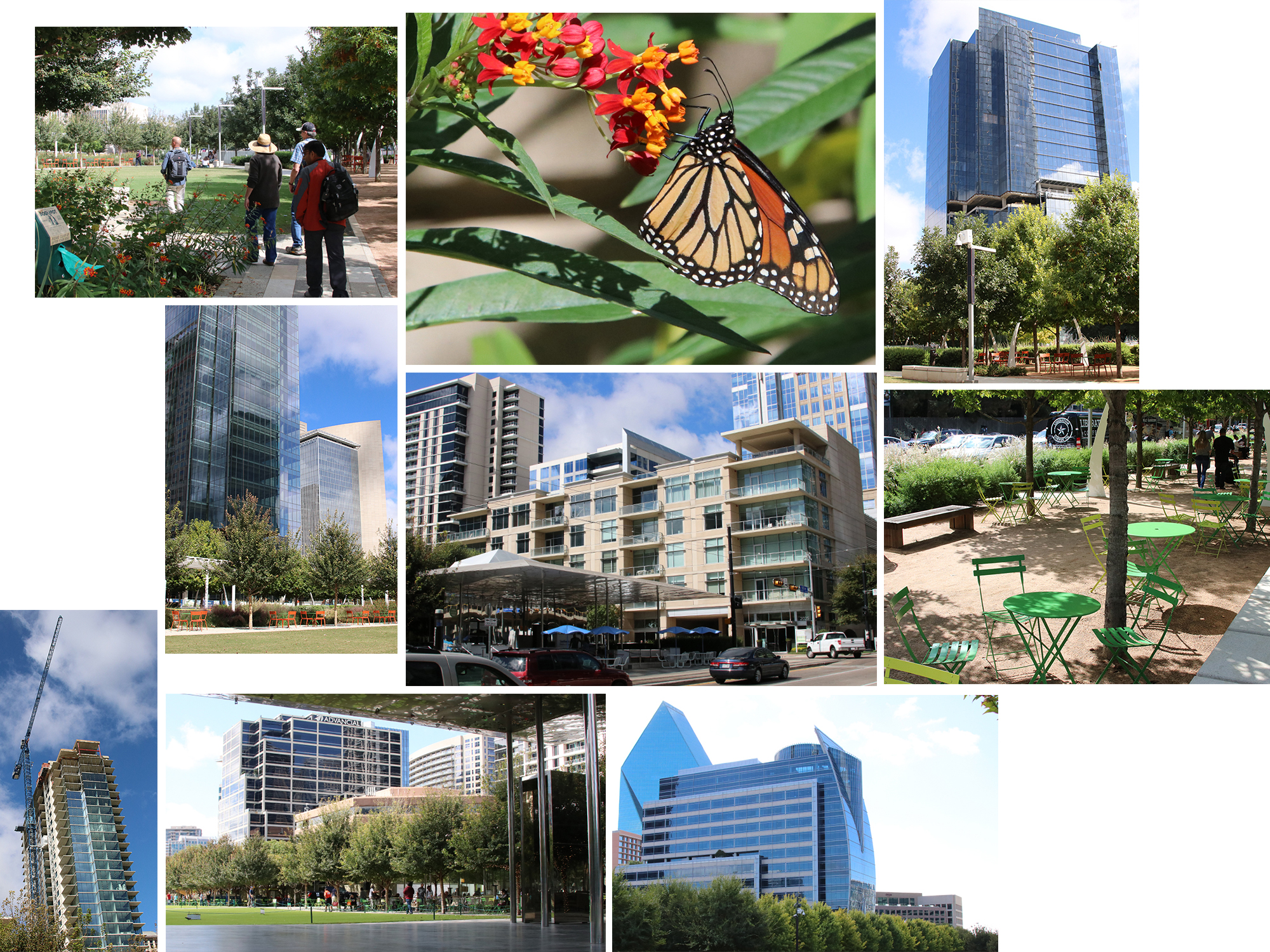
A group of migratory Turkey Vultures was spotted at altitude just as we were about to call it a day. They were so high that our cameras could not achieve proper focus. But I was thrilled to see them, nonetheless. This was one of the things that was on my observation wishlist for the weekend.

As advertised, we finished up with a nice lunch at the historic original El Fenix location on the north side of downtown. There was a surprise guest at the restaurant too, spotted visiting with the patrons—Alfred Martinez, 98 years old and the last surviving son of restaurant founder Miguel Martinez. What a great way to end the day’s events!
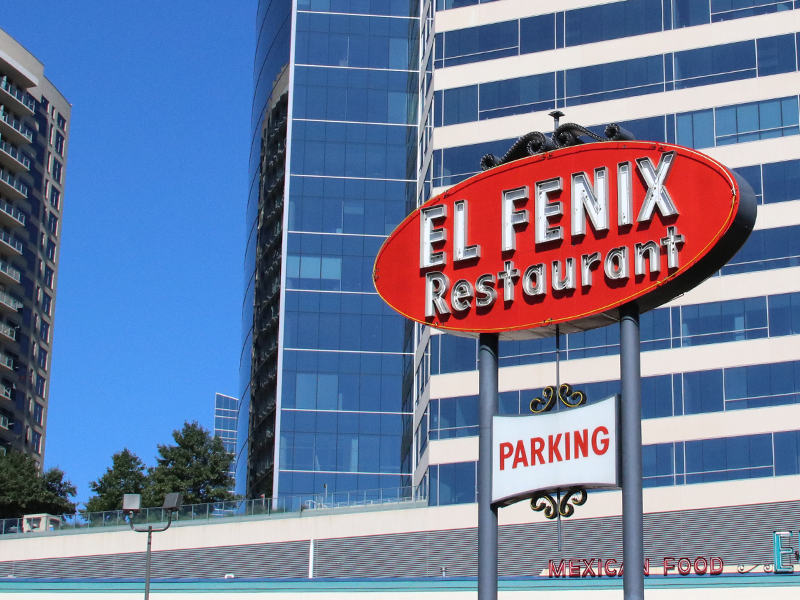
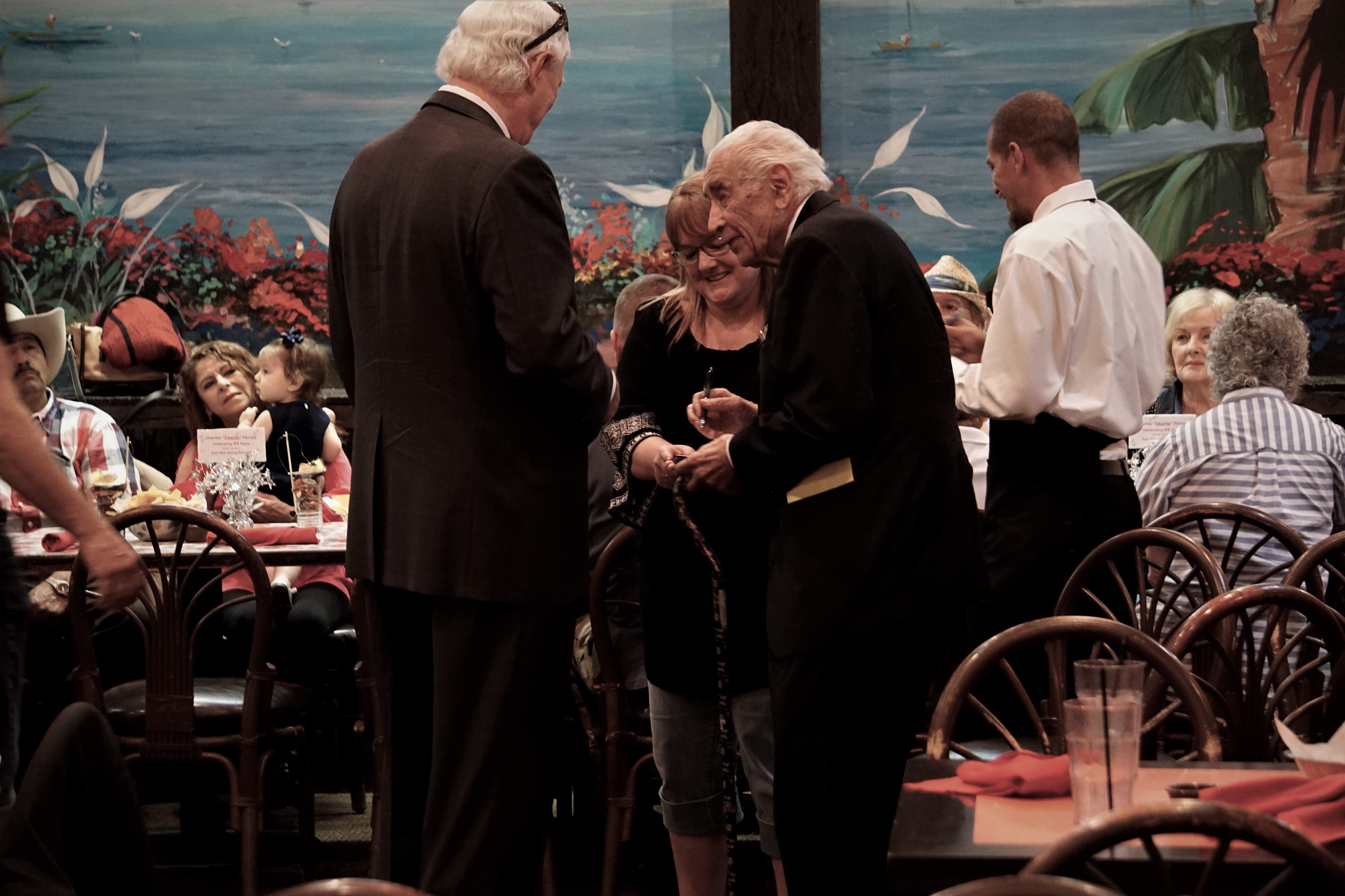
All in all, I think this meetup was a noble experiment. It’s one of those outings that I remember more and more fondly every time I think about it. I believe we all gained some valuable insight into the types and kinds of wildlife that are adaptable enough to make their way in the most urban of all urban North Texas environments. But, there is certainly more to be discovered. Follow up visits will be scheduled—likely targeting very specific parks and common areas.
In the meanwhile be sure and check out this great little video recap of the day’s encounters. The incomparable videographer, Richard Barnes, walked with us on Sunday, and afterwards he put together this fantastic montage of our best wildlife observations and views of the city. It’s a great way to get a sense of the fun that was had by all!


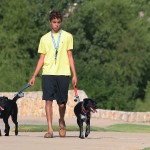
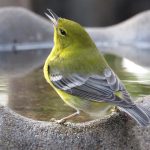

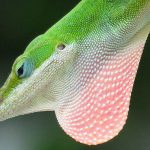
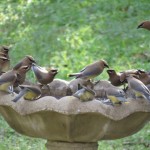
This is the third time I’ve re-read this and looked at the photos, and it brings back nice memories. Despite being in the midst of the hustle and bustle of downtown Dallas (busy even on the weekend), it really was quite an adventure!